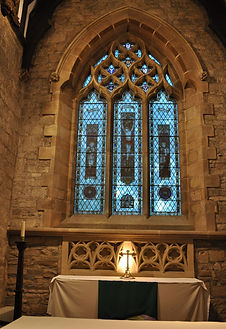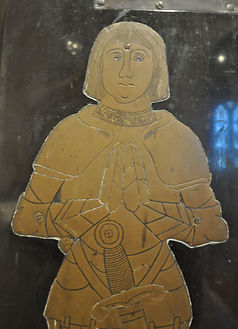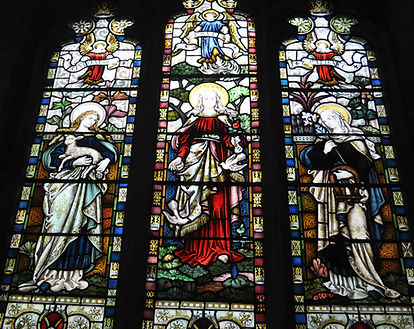It was an early start for this February 2020 visit to the Hope Valley area. It was pitch black when we set off, and the forecast for the area was a good one; plenty of sun to look forward to. The sat nav suggested an arrival time of 9am at Hathersage, the church of St Michael and All Angels, the first church of the day, we arrived three minutes after that!
Hathersage is a beautiful village, with a population of around 1,400, just north of the river Derwent. The village itself is on the edge of Surprise View, which gives some of the most glorious views in the whole of the Peak District.
There was mention of a village here at the time of the Domesday Survey in 1086, but the first church built here is thought to be early 12th century. The church that we see today dates from the late 14th to early 15th century, with restoration in the mid 19th century, The church consists of west tower, with recessed crocketed octagonal spire, nave with north and south aisles and clerestories, south porch and chancel with former chantry chapel, that was added in 1463 to the Eyre family.
The sun was just breaking through for the first time as we arrived, and light quality wasn’t great at that time, but was to improve greatly as the day wore on. As you might expect from mid winter in the Peak District, it was really cold, with snow covering the area the following day.
The church is set back a little from the main road through the village, and is on high ground. On entering, it was pretty dark inside, but a light hand been left on in the chancel, actually in the reredos behind the alter cross, which gave a very lovely effect. I turned on the rest of the lights, which I don’t like to do unless necessary, and set to work!
All of the stained glass here seems to date from the Victorian restoration with the exception of the east window. This has a depiction of the crucifixion; this window was originally in Derwent church and was reset here in 1948 after the creation of Derwent reservoir and the loss of that village to the waters! I was interested to see a trinity shield high up in the tracery of that window. This being a visual aid to help identify what the three parts of the Holy Trinity (Father, Son and Holy Spirit) are and aren’t!
The Father is God" "The Son is God" "The Holy Spirit is God" "God is the Father" "God is the Son" "God is the Holy Spirit" "The Father is not the Son" "The Father is not the Holy Spirit" "The Son is not the Father" "The Son is not the Holy Spirit" "The Holy Spirit is not the Father" "The Holy Spirit is not the Son"
To the north wall of the chancel is a chest tomb to Robert Eyre and his wife Joan, Robert passing away in 1459. There is a memorial brass on top of this tomb, and further brasses set in to a recess against the north wall.

The church grounds are fairly tight, which makes photographing the exterior a frustrating experience; there are gargoyles and grotesque on all sides of the church, with some fabulously contorted human faces. Glancing over to the south west, there was a breathtakingly beautiful view of the hills off in the distance, lit by the weak winter sun.
There wasn’t a great deal of interest in the church grounds with the exception of the alleged grave of Little John of Robin Hood fame. A modern gravestone marks the site, the grave site itself being well maintained, very long indeed and marked by railings on all four sides. There is also a fragment of a medieval cross shaft to the south of the church, which had a Grade II listing.
BAMFORD : CHURCH OF ST JOHN THE BAPTIST
Church Post Code S33 0BD
Open to visitors


We headed a few miles to the North West, with next point of call being Bamford, and the church of St John The Baptist. The village here was mentioned in the Domesday Survey; and is popular with walkers. The village is surrounded by high moorland and the river Derwent runs through the village.
At first glance, this was obviously a Victorian church, which it turns out was designed by William Butterfield and opened in 1860. Looking at the church from the south we have a slender west tower, offset to the north slightly, with steeple, nave with north aisle and chancel. There is no south porch here, with entry to the church through a door on the west face of the tower. The church was open to visitors.
Moving inside, there is plenty of stained glass here and, as a result, it was a little dull inside despite the bright conditions outside.
The alter is plain and tasteful; just a rustic cross and an open Bible with basic reredos behind of tiles with alternating trefoil and quatrefoil designs. The east window is of interest, Almost cartoon like in appearance, this depicts the ascension and the resurrection; three panels to each, with the resurrection below the ascension.

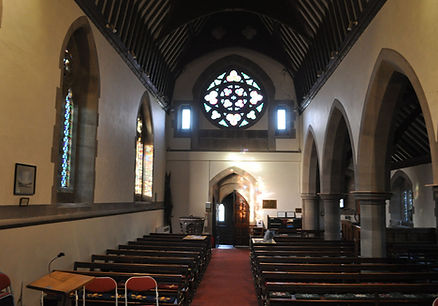
he resurrection shows Jesus, coming triumphantly out of the tomb, sleeping Roman soldiers at His feet, with the women coming to tend the tomb to the left as we look at it and a rather puzzled looking Peter and John to the right. Obviously, there is poetic license here as the tomb was empty by the time that the women arrived, who were first on the scene that Easter morning.
The panels above show the ascension. Jesus is raised up, His feet, with wounds visible, and the bottom part of His robe all that we can see as He is taken up in to Heaven. Peter and John are below, looking up at Jesus, Peter holding the keys to the Kingdom of Heaven, John at prayer. Disciples are to the side panels, all registering shock at what they are seeing.
Another stained glass window here shows Jesus being baptised by John the Baptist. This is on the centre panel of three, with Zechariah, wearing priestly robes and wielding a censer and Elizabeth; John the Baptist’s parents, on either side. The winter sunshine was streaming in through the south windows, with beautiful multi coloured reflections being created through the glass.


As is mostly the case, it is worth while looking high up in the tracery of windows. Here we have a series of six angels playing musical instruments, circled around a central cross. At the west end of the nave we have a beautiful rose window, in which the four Gospel writers are depicted in symbol form around the letters INRI. These initials stand for IESVS NAZARENVS REX IVDÆORVM which translated reads "Jesus the Nazarene, King of the Jews", which was the inscription that was put on to Jesus’ cross before crucifixion.
With this being a Victorian church, there was little in the church grounds of any interest but it is worth noting that the dead from Derwent church were re-buried here after that village was flooded in creating the Ladybower dam.
Standing in the church grounds, looking south; I enjoyed the hills off in the distance, with all their subtle hues as the sun continued to take hold. Breath was coming out in steam; fingerless gloves despite the sun. It was 113 miles from Peterborough and I was up at six. Was it worth it? Heck, yes it was worth it!
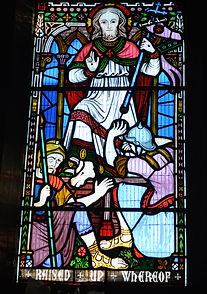

HOPE : CHURCH OF ST PETER


Church Post Code S33 6RD
Closed to visitors
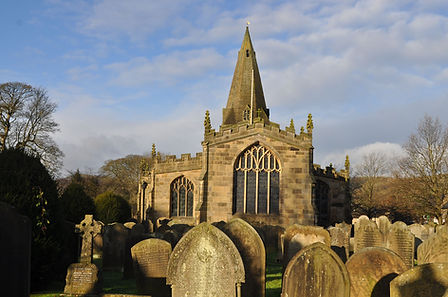
We rejoined the A6187 and headed towards Hope. By this time, the sun was shining brightly and the lighting conditions were excellent. As with this entire area, there is a great deal of history here. A Roman road, Batham Gate and a Roman fort, Navio were situated just outside the village.
The church of St Peter sits by the side of the main road and was sadly closed to visitors. The church that we see today dates from the 14th and 15th centuries. Anyone walking up to the south porch though and seeing the Saxon cross shaft on our right, will doubtless have an idea that there was a church here before that time.
There was restoration work here during the 18th and 19th centuries. The west tower was rebuilt in 1728 and the chancel was rebuilt in 1881/82. The church consists of heavily buttressed west tower with octagonal spire, nave with aisles and clerestories, south porch and chancel. The nave, chancel and south porch are battlemented and pinnacled throughout.
Stone heads gaze out from throughout the structure, including small heads on the pinnacles. A winged, mythical creature shows a ferocious looking set of teeth to those walking up the patch towards the south porch. Close by, a vaguely human like creature, with a curiously alien like face pulls open its mouth in medieval gesture of insult.

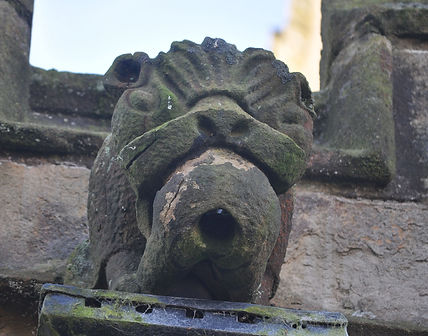

Another strange looking beast is captured in the act of eating another animal, the rear end of the luckless victim sticking out of its mouth! Amusingly, the water comes out here through a hole cut in to the backside of the animal being eaten!
One creature has a wild hairstyle, staring eyes and is grimacing. If ever there was a grotesque that best sums up the covid year of 2020, it is probably this one! With regards the hairstyle, and yes perhaps the staring eyes, I bet all of us who have taken part in Zoom meetings during the covid months have encountered similar!
The church grounds here are of great interest. There are two crosses here, each one a listed monument. To the south of the church is a Saxon cross shaft, mounted on to a modern base. This dates back to the 11th century. Close by is the vase of a medieval cross, with a modern shaft mounted on to it. The base is on top of what looks like an old market/butter cross with five steps leading up to the top,
One gravestone dated 1808, to Rachel Gleadhill who passed away in 1808 aged 16 years is still as moving today as on the day that it was carved. It reads ‘Unto this stone who e’er thou art draw near, Here lieth one belov’d our daughter dear, who gave her parents joy and friendship did divide, but never gave us grief until the day she died’.
CASTLETON : CHURCH OF ST EDMUND
Church Post Code S33 8WE
Open to visitors


It was a short trip to Castleton, the final church that I will look at on this page. I had visited here on a couple of occasions before, taking the bus from Sheffield whilst stopping in Chesterfield. I have fond; no perhaps that is not the right word, just memories of waiting in Castleton bus station on a Sunday afternoon. My bus pulled in to the station and hit another bus. We made it back to Sheffield with parts of the bus and a fair bit of liquid left on the floor at Castleton! Who needs brake fluid anyway!
Castleton is a big tourist attraction, being situated very close to Mam Tor, also known as the ‘Shivering Mountain’. The ruins of the Norman Peveril castle are high up at the edge of the village. Castleton is home to many caverns and ‘Blue John’ is mined here. A stone that is unique to this area.
The church of St Edmund was originally built during the 12th century, with the church being added to during the 14th century. At one time there were north and south aisles here; these being demolished in 1831 at which time the south porch was built.
The church was open to visitors and I was immediately struck by some lovely old box pews. Several of these had names and dates on them, some of them to members of the Hall family with dates from the mid to late 17th century, including the 1660’s. Eyam is only a few miles away to the north. I wonder what fears these people had as the plague raged amongst their neighbours; and how much gratitude they had that their sacrifice had made their own village plague free!
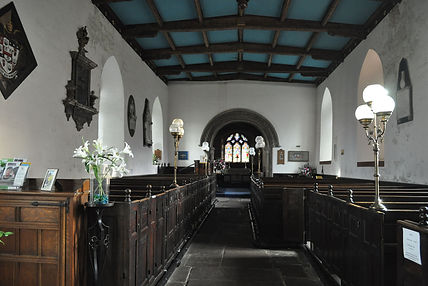

The chancel is plain and simple and beautiful. Just candlesticks and a cross on the alter, a candle lit in a holder on the north chancel wall; sunlight casting multi coloured reflections through the stained glass. A simple place; a place to be still! No worship bands here, no thousand strong congregations, no bells and whistles. I have nothing against any of that, but there is a place for that and it is not here. ‘Be still and know that I am God’.
There is some stained glass here. The east window shows three scenes from the life of Christ, the centre panel depicting Jesus cradling a lamb. One of the other panels on this window has left me a little puzzled though. We have Jesus surrounded by his disciples; Peter kneeling and holding the keys to the Kingdom of Heaven. This looks like standard depiction of Jesus reinstating Peter after his betrayal on the night of Jesus’ trial. However, Jesus, with both hands visible, has no crucifixion wounds visible! This I find strange. The Victorians had a habit of sanitising things to suit the sensibilities of the audience of the day. Surely, though they would do this to the extent that they take out Christ’s wounds?
Other glass includes a window to St Edmund, who is portrayed as usual carrying arrows; this being the manner of his death at the hands of the Vikings. Edmund was King of East Anglia and I thought that it was odd to see the church this far north dedicated to him but he was also regarded as the patron saint of England.
The box pews are of interest as they have the names and dates of donors on them, with several to members of the Hall family, with dates from either side of the time that the Bubonic plague hit the country in the 17th century.
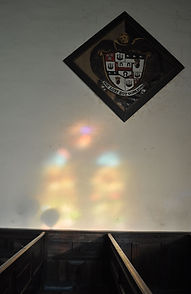






The church grounds are of interest, with many gravestones back to the 18th century. To be fair, there is nothing of great importance in the grounds but there is a very interesting 18th century gravestone which has several masonic symbols on it, including a Masonic Eye symbol, the eye of providence.
An epitaph at the foot of the grave to John Nall, parish clerk, who died in 1811 reads ‘Within the borders of the grave, he still and quiet lies, until the Lord shall bid him come, and with the Saints to rise’.
This is an area of for the most part open and welcoming churches. Only Hope was closed to visitors on the day and a quick check on that churches 'A Church Near You' page indicates that they are also now open at weekends.
It was a delight to be back here again. This whole area is well worth taking a look at if you are in the area,




